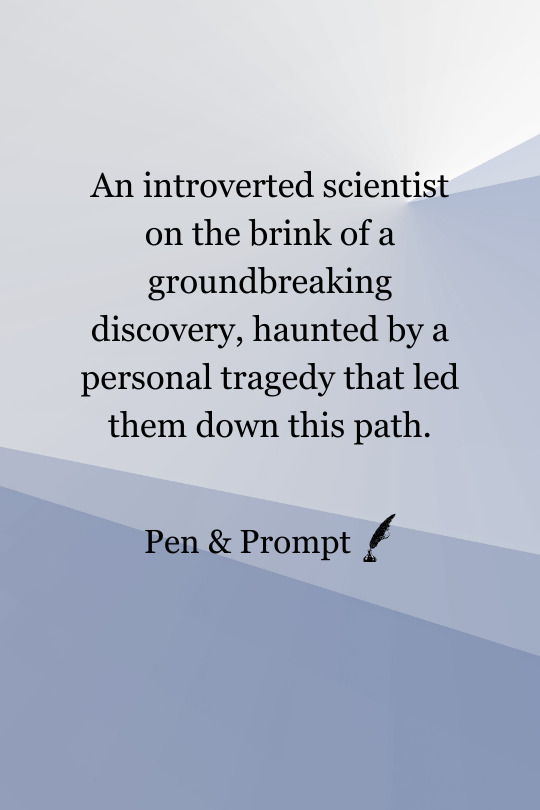#WritersBlockBusters
Text

#WritingPrompts#CreativeWriting#AmWriting#WritersCommunity#WritingChallenge#PromptOfTheDay#GetInspired#WritingIdeas#StoryStarter#WriteYourStory#ImaginationFlow#WritersBlockBusters#DailyWritingExercise#FictionWriting#CharacterPrompts#SettingInspiration#WordPrompts#NarrativePrompts#WritingJourney
2 notes
·
View notes
Text
0 notes
Photo

(Time for some #writersblockbusters awesomeness!! 👻🎥, But first:🚨 . VERY rarely does anyone “just get it” and even those individuals that seem it will tell you that they’ve had help, quality inspiration, and mentors along the way. You absolutely NEED to seek and find what works and as many possible ways to comprehend and learn the basic and structured, yet endlessss aspects to writing/screenplay writing/filmmaking or any creative passion really. The world around you is always changing and you’re always changing. With change comes different ways of thought and feelings towards elements in your life and in the world at large. 📝💯 . Also, make sure to have a good time during your word life travels!! Consume quality awesomeness esp from other writers and filmmakers who do it for the love andddd business hustle. I say that, because these humans who put this podcast on juggle all that and always produces quality in all respects! Check em out and dig through their past work offerings to. I think you’ll be surprised and some of the gems you will find. Enjoy! 👊🏼💥 *I have Demolition Man on Laserdisc 🤦🏼♂️💿📽) . #Repost @_jimmygeorge @tcviani ・・・ PODCAST LINK IN MY PROFILE! On WRITERS/BLOCKBUSTERS we analyze movies for #screenwriting tools and techniques. This week @ThunderGruntBob, @jamie4475 and I discuss DEMOLITION MAN! Screenwriting Topics on this Episode: • Setting the Tone • Why the 38 min First Act works • Who is the protagonist? • Premise Delivery • Praise of the Killer Speeches • What’s the theme and how is it expressed?🌟 https://www.instagram.com/p/B4QFLQHl-Q3/?igshid=1mgkqmsp6eu26
0 notes
Text
Skin Colour
Hi again! I am so sorry for giving you guys a horribly written question.
First, aliens did not interfere with genetics anything more advanced than today. They interfered only with advancement of civilisation and knowledge.
Secondly, the generations part. To summarise:
Alien planet year 0 = technology and human’s knowledge equal to Earth 150000 BC
Alien planet year 3500 (after 50 generations) = technology and inhabitant’s knowledge equal to Earth 2000 AD (after 3000 generations)
On Earth, dark skinned humans slowly moved north/south for thousands of generations and skin turned lighter. It was impossible to see a light skin at the equator and dark skin way up north/south until people learned technology to travel fast enough to spread.
On my alien world, x skin inhabitants had learned the technology to travel fast and went far north/south way way earlier than Earth. They’d keep their x skin right? Not enough generations to slowly adapt to another colour.
Is my thinking correct? That in my alien world that’s how skin colour would work? Maybe I’m thinking only about melanin, and it only works this way. But say they had grey skin, or blue skin.
Thus, perhaps I need to completely drop melanin and think something way different? I have no real idea how animal skin colour works.. but on Earth we do not get dark skinned animals at the equator and light skinned animals far north/south. Who says my I can’t create my species that way too, just because I’m making humanoid species.
--
This is a follow up to: https://script-a-world.tumblr.com/post/185522126817/hi-so-human-skin-colour-evolved-over-hundreds-of
Tex: Ah, that makes much more sense, thank you for the clarification, and don’t worry about coming back to do that!
Today, humans can meddle quite a bit with genetics - while CRISPR-Cas9 is rife with errors (ResearchGate), the newly-discovered CRISPR-associated transposase (CAST) technique is much more stable and can insert entirely custom genes into DNA (Phys.org), so the genes behind melanogenesis - among probably every other gene in existence - is perfectly able to be edited by your humanoid species with very little fuss.
The 50 generations thing is still a sticking point, unfortunately. Why are these generations so comparatively condensed compared to a human 3,000 generations? What makes these generations so compressed - is it strictly technological development (tools, textiles, etc), is it strictly genetic (epigenetic factors), or a mix of both?
How fast is fast travel? @writersblockbuster made an excellent post on calculating travel times, and she has estimated that a human “could manage almost 25 miles (40 km) in 8 hours” at walking speed depending upon a variety of factors. Provided that only eight hours is taken per 24-hour period to walk at this pace, uninterrupted by other factors, then it would take a human about 40 days to traverse 1,000mi/1,600km. Where does your method of transportation fall in comparison to that?
Melanin is the product of what is, quite typically for genetics, a convoluted process. It’s produced by melanosomes, which are produced by melanocytes, which are produced by neural crest melanoblasts - so all of this begins in the brain! There’s a lot of players in the body that make sure melanocytes are delivered to places like the epidermis, and melanin in epidermal cells seems to primarily exist as protection against both UVA and UVB radiation. (Citations 1-5)
Now, there are two main types of melanin, of which humans have both (PDF): eumelanin and pheomelanin. The range for these would be the typical range of human natural hair colors. Plants may produce biological pigments which refract all but which they reflect (i.e. a blue flower absorbs all wavelengths except for that particular blue, which is what is refracted back; WebExhibits), but animals are unable to produce the more “exotic” colors in their epidermis and must rely on either their diet or structural coloration (such as the iridescence in some feathers), instead (WebExhibits). A notable exception to this would be the Ayam Cemani chicken from Indonesia (Wikipedia).
Exposure to UV radiation does not come strictly from the sun - freshly-fallen snow can reflect up to 80% of UV radiation and can cause photokeratitis (Wikipedia). Polar bears have black skin, and only look white because their hair strands are hollow and refract light back that looks white (World Wildlife Fund). Zebras, too, have black skin (Wikipedia), and currently I’m presuming that it’s for much the same reason as polar bears.
Eumelanin, at least in hair, can produce a grey color, though I’m uncertain how a grey skin color would come about without the inherent design of structural coloration within the epidermis to diffuse… probably eumelanin, I think, into what could be perceived as grey.
Blue is rare in nature (YouTube), but if structural color doesn’t appeal to you, then the idea of cyanomelanin for skin and hair has been discussed in such places as Reddit and Zompist’s Almeopedia - there’s also a slim possibility of copper oxyanions or other copper compounds (disclaimer that biochemistry isn’t my strong suit, and that an actual biochemist would be a better reference on this). If a biological blue pigment is the case, then the visible light spectrum for your planet might also need to be shifted in order to accommodate this (PDF).
Melanin is a good foundation for your idea, but you’ll need to rip out the specifics of melanogenesis and determine what the pigment synthesis pathways would be that would create grey or blue skin.
My particular vote is to utilize both structural color and biological pigmentation; a blue base that may or may not be diffused by multiple layers in the epidermis, so you can get a grey skin color if that’s more preferred than blue, would be the most feasible method that would be genuinely alien to human physiology. Something closer would be a base layer of eumelanin-rich epidermis that has some upper layer of structural blue (possibly the foam-based one mentioned in the YouTube video) that could be diffused out with an extra layer to get you a type of grey.
But to bring back to one of your original questions - no, 50 generations is most likely not enough time for your species to naturally adapt to a different skin color, however many ways there are to make grey or blue aliens.
Citations
PDF - Brenner, Michaela, and Vincent J. Hearing. "The protective role of melanin against UV damage in human skin." Photochemistry and photobiology 84.3 (2008): 539-549.
PDF - Roméro-Graillet, Christine, et al. "Nitric oxide produced by ultraviolet-irradiated keratinocytes stimulates melanogenesis." The Journal of clinical investigation 99.4 (1997): 635-642.
Abstract - Salim, Saima, Ayesha S. Ali, and Sharique A. Ali. "Insights into the physiomodulatory role of histaminergic receptors in vertebrate skin pigmentation." Journal of Receptors and Signal Transduction 31.2 (2011): 121-131.
PDF - F. Solano, “Melanins: Skin Pigments and Much More—Types, Structural Models, Biological Functions, and Formation Routes,” New Journal of Science, vol. 2014, Article ID 498276, 28 pages, 2014.
PDF - Videira, Inês Ferreira dos Santos et al. “Mechanisms regulating melanogenesis.” Anais brasileiros de dermatologia vol. 88,1 (2013): 76-83. doi:10.1590/s0365-05962013000100009
Further Reading
Melanin - Wikipedia
Topic: Eumelanin - ScienceDirect
Topic: Pheomelanin - ScienceDirect
Melanin biosynthesis - WikiPathways
PDF - Braasch, Ingo et al. “Evolution of pigment synthesis pathways by gene and genome duplication in fish.” BMC evolutionary biology vol. 7 74. 11 May. 2007, doi:10.1186/1471-2148-7-74
PDF - Sturm, Richard A, and David L Duffy. “Human pigmentation genes under environmental selection.” Genome biology vol. 13,9 248. 27 Sep. 2012, doi:10.1186/gb-2012-13-9-248
PDF - Quillen, Ellen E., et al. "Shades of complexity: New perspectives on the evolution and genetic architecture of human skin." American journal of physical anthropology 168 (2019): 4-26.
List of examples of convergent evolution - Wikipedia
PDF - Esposito R, D'Aniello S, Squarzoni P, Pezzotti MR, Ristoratore F, et al. (2012) “New Insights into the Evolution of Metazoan Tyrosinase Gene Family.” PLOS ONE 7(4): e35731.
PDF - Vladimir N. Babenko, Dmitri M. Krylov, “Comparative analysis of complete genomes reveals gene loss, acquisition and acceleration of evolutionary rates in Metazoa, suggests a prevalence of evolution via gene acquisition and indicates that the evolutionary rates in animals tend to be conserved,” Nucleic Acids Research, Volume 32, Issue 17, 1 September 2004, Pages 5029–5035
Abstract - Horemans, Nele, et al. "Current evidence for a role of epigenetic mechanisms in response to ionizing radiation in an ecotoxicological context." Environmental Pollution (2019).
PDF - Aguilera, Felipe, Carmel McDougall, and Bernard M. Degnan. "Origin, evolution and classification of type-3 copper proteins: lineage-specific gene expansions and losses across the Metazoa." BMC evolutionary biology 13.1 (2013): 96.
23 notes
·
View notes
Photo

#campnanowrimo Day 23: Monday Motivation: Writer’s Block Busters. Some things that have helped me with writer’s block are: ✑ Setting up a writing routine. ✑ Reviewing/updating my outline. ✑ Taking a shower/bath. ✑ Listening to music. Usually songs that evoke emotion for the scene I’m working on. ✑ Keep writing! I try to write everyday even if it’s a blog post or short story. • • • #amwriting #amwritingfantasy #bookish #writersofig #igwriters #igwritersclub #writingcommunity #igwriters #writersofinstagram #writersbelike #authorsbelike #iwrite #writer #writing #aspiringauthor #keepwriting #campnanowrimo #campnanowrimo2018 #julynanowrimo #nanowrimo #nanowrimophotochallenge #campinstawrimo #writerslife #mondaymotivation #writersblock #writersblockbusters
#writersofig#aspiringauthor#writingcommunity#campnanowrimo#keepwriting#iwrite#igwriters#writersbelike#nanowrimophotochallenge#campinstawrimo#igwritersclub#nanowrimo#julynanowrimo#writersblockbusters#writerslife#writing#writersofinstagram#campnanowrimo2018#mondaymotivation#writersblock#amwritingfantasy#bookish#authorsbelike#writer#amwriting
0 notes
Photo

The Dictionary of Medieval Names from European Sources aims to document all given names recorded in European sources written between 600 and 1600.
4K notes
·
View notes
Text

#WritingPrompts#CreativeWriting#AmWriting#WritersCommunity#WritingChallenge#PromptOfTheDay#GetInspired#WritingIdeas#StoryStarter#WriteYourStory#ImaginationFlow#WritersBlockBusters#DailyWritingExercise#FictionWriting#CharacterPrompts#SettingInspiration#WordPrompts#NarrativePrompts#WritingJourney
2 notes
·
View notes
Text

#WritingPrompts#CreativeWriting#AmWriting#WritersCommunity#WritingChallenge#PromptOfTheDay#GetInspired#WritingIdeas#StoryStarter#WriteYourStory#ImaginationFlow#WritersBlockBusters#DailyWritingExercise#FictionWriting#CharacterPrompts#SettingInspiration#WordPrompts#NarrativePrompts#WritingJourney
2 notes
·
View notes
Text

#WritingPrompts#CreativeWriting#AmWriting#WritersCommunity#WritingChallenge#PromptOfTheDay#GetInspired#WritingIdeas#StoryStarter#WriteYourStory#ImaginationFlow#WritersBlockBusters#DailyWritingExercise#FictionWriting#CharacterPrompts#SettingInspiration#WordPrompts#NarrativePrompts#WritingJourney
2 notes
·
View notes
Text

#WritingPrompts#CreativeWriting#AmWriting#WritersCommunity#WritingChallenge#PromptOfTheDay#GetInspired#WritingIdeas#StoryStarter#WriteYourStory#ImaginationFlow#WritersBlockBusters#DailyWritingExercise#FictionWriting#CharacterPrompts#SettingInspiration#WordPrompts#NarrativePrompts#WritingJourney
0 notes
Text

#WritingPrompts#CreativeWriting#AmWriting#WritersCommunity#WritingChallenge#PromptOfTheDay#GetInspired#WritingIdeas#StoryStarter#WriteYourStory#ImaginationFlow#WritersBlockBusters#DailyWritingExercise#FictionWriting#CharacterPrompts#SettingInspiration#WordPrompts#NarrativePrompts#WritingJourney
1 note
·
View note
Text

#WritingPrompts#CreativeWriting#AmWriting#WritersCommunity#WritingChallenge#PromptOfTheDay#GetInspired#WritingIdeas#StoryStarter#WriteYourStory#ImaginationFlow#WritersBlockBusters#DailyWritingExercise#FictionWriting#CharacterPrompts#SettingInspiration#WordPrompts#NarrativePrompts#WritingJourney
0 notes
Text

#WritingPrompts#CreativeWriting#AmWriting#WritersCommunity#WritingChallenge#PromptOfTheDay#GetInspired#WritingIdeas#StoryStarter#WriteYourStory#ImaginationFlow#WritersBlockBusters#DailyWritingExercise#FictionWriting#CharacterPrompts#SettingInspiration#WordPrompts#NarrativePrompts#WritingJourney
0 notes
Text

#WritingPrompts#CreativeWriting#AmWriting#WritersCommunity#WritingChallenge#PromptOfTheDay#GetInspired#WritingIdeas#StoryStarter#WriteYourStory#ImaginationFlow#WritersBlockBusters#DailyWritingExercise#FictionWriting#CharacterPrompts#SettingInspiration#WordPrompts#NarrativePrompts#WritingJourney
0 notes
Text

#WritingPrompts#CreativeWriting#AmWriting#WritersCommunity#WritingChallenge#PromptOfTheDay#GetInspired#WritingIdeas#StoryStarter#WriteYourStory#ImaginationFlow#WritersBlockBusters#DailyWritingExercise#FictionWriting#CharacterPrompts#SettingInspiration#WordPrompts#NarrativePrompts#WritingJourney
0 notes
Text

#WritingPrompts#CreativeWriting#AmWriting#WritersCommunity#WritingChallenge#PromptOfTheDay#GetInspired#WritingIdeas#StoryStarter#WriteYourStory#ImaginationFlow#WritersBlockBusters#DailyWritingExercise#FictionWriting#CharacterPrompts#SettingInspiration#WordPrompts#NarrativePrompts#WritingJourney
0 notes